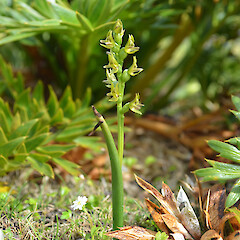Prasophyllum colensoi
Common name
leek orchid
Synonyms
Prasophyllum pauciflorum Col.
Family
Orchidaceae
Flora category
Vascular – Native
Endemic taxon
Yes
Endemic genus
No
Endemic family
No
Structural class
Orchids
NVS code
The National Vegetation Survey (NVS) Databank is a physical archive and electronic databank containing records of over 94,000 vegetation survey plots - including data from over 19,000 permanent plots. NVS maintains a standard set of species code abbreviations that correspond to standard scientific plant names from the Ngä Tipu o Aotearoa - New Zealand Plants database.
PRACOL
Chromosome number
2n = 42
Current conservation status
The conservation status of all known New Zealand vascular plant taxa at the rank of species and below were reassessed in 2017 using the New Zealand Threat Classification System (NZTCS) – more information about this can be found on the NZTCS website. This report includes a statistical summary and brief notes on changes since 2012 and replaces all previous NZTCS lists for vascular plants.
Please note, threat classifications are often suggested by authors when publications fall between NZTCS assessment periods – an interim threat classification status has not been assessed by the NZTCS panel.
- Conservation status of New Zealand indigenous vascular plants, 2017 . 2018. Peter J. de Lange, Jeremy R. Rolfe, John W. Barkla, Shannel P. Courtney, Paul D. Champion, Leon R. Perrie, Sarah M. Beadel, Kerry A. Ford, Ilse Breitwieser, Ines Schönberger, Rowan Hindmarsh-Walls, Peter B. Heenan and Kate Ladley. Department of Conservation. Source: NZTCS and licensed by DOC for reuse under the Creative Commons Attribution 4.0 International licence.
2017 | Not Threatened
Previous conservation statuses
2012 | Not Threatened
2009 | Not Threatened
2004 | Not Threatened
Distribution
Endemic. North, South, Stewart, Chatham, Antipodes and Auckland Islands
Habitat
Coastal to alpine in wetlands, gumland and subalpine scrub, successional forest, tussock grassland, herb and fellfield
Wetland plant indicator status rating
Information derived from the revised national wetland plant list prepared to assist councils in delineating and monitoring wetlands (Clarkson et al., 2021 Manaaki Whenua – Landcare Research Contract Report LC3975 for Hawke’s Bay Regional Council). The national plant list categorises plants by the extent to which they are found in wetlands and not ‘drylands’. The indicator status ratings are OBL (obligate wetland), FACW (facultative wetland), FAC (facultative), FACU (facultative upland), and UPL (obligate upland). If you have suggestions for the Wetland Indicator Status Rating, please contact: [Enable JavaScript to view protected content]
FAC: Facultative
Commonly occurs as either a hydrophyte or non-hydrophyte (non-wetlands).
Detailed description
Terrestrial, tuberous, fleshy, glabrous, summer-green, perennial herb up to 300 mm tall when flowering. Tuber shortly ovoid, adjacent to or occasionally up to 10 mm away from previous seasons tuber. Stem erect, more or less smooth, terete, dark green basally tinged with red. Leaf shorter than or overtopping raceme; 100-300 mm long, dark green or reddish green, if dark green with base tinged red, terete, hollow, linear-lanceolate, apex acute. Inflorescence racemose. Raceme 5-20-flowered, flowers evenly spaced, or clumped together and more or less overlapping. Perianth green, yellowish-green, pale yellow, reddish-green to dark red or maroon, colours sometimes intermixed on the same plant. Dorsal sepal 5 mm long, ovate, concave, sometimes recurved; lateral sepals slightly longer, narrower, weakly fused in bud and usually remaining so at least near base, channelled, apex minutely cucullate, shortly apiculate, appearing bidentate. Petals a little shorter, wider, more delicate. Labellum of similar length, narrowed at base and almost sessile, occasionally shortly clawed, ovate, recurved but not abruptly so; margin entire, smooth to undulate; callus extending as an irregularly thickened median band almost to the narrowly subacute apex. Lateral processes of column bilobed, anterior lobe membranous and slightly shorter than anther; posterior lobe much smaller and more or less callus-like. Anther sessile, just overtopped by rostellum. Stigma barely its own height above column-base.
Manaaki Whenua Online Interactive Key
Similar taxa
Could be confused with Prasophyllum hectorii (Buchanan) Molloy, D.L.Jones et M.A.Clem., which is a species of acidic wetlands where it usually grows partially submerged in water. Prasophyllum colensoi differs by its usually smaller size (up to 300 mm c.f up to 1 m tall in P. hectorii) and fewer, scarcely scented flowers (up to 20 cf. up to 80 in P. hectorii). The callus of the labellum in P. colensoi extends almost to the narrow apex; that of P. hectorii is more or less confined to the proximal portion, with the labellum apex wide, pale and mostly undulose.
Flowering
October - March
Flower colours
Green, Yellow
Fruiting
January - June
Propagation technique
Easily grown in a sunny, free draining soil. Excellent in pots. Should not be removed from the wild.
Etymology
prasophyllum: From the Greek ‘prasos’ leek and phyllos ‘leaf’
colensoi: Named after William Colenso (7 November 1811 - 10 February 1899) who was a Cornish Christian missionary to New Zealand, and also a printer, botanist, explorer and politician.
Where To Buy
Not commercially available.
TAXONOMIC NOTES
Recent molecular and morphological studies, as yet unpublished suggest that the two New Zealand Prasophyllum will need placing in another, as yet undescribed new genus (Peter Weston pers. comm. November 2014)
Prasophyllum colensoi is an aggregate species and at least two further, possibly unnamed entities warranting specific recognition could be separated from it. Forms found in Northland and on Great Barrier Island are especially distinctive.
Attribution
Fact Sheet prepared for NZPCN by P.J. de Lange 14 April 2007. Description adapted from Moore and Edgar (1970).
References and further reading
Moore, L.B.; Edgar, E. 1970: Flora of New Zealand. Vol. II. Government Printer, Wellington.
NZPCN Fact Sheet citation
Please cite as: de Lange, P.J. (Year at time of access): Prasophyllum colensoi Fact Sheet (content continuously updated). New Zealand Plant Conservation Network. https://www.nzpcn.org.nz/flora/species/prasophyllum-colensoi/ (Date website was queried)



















